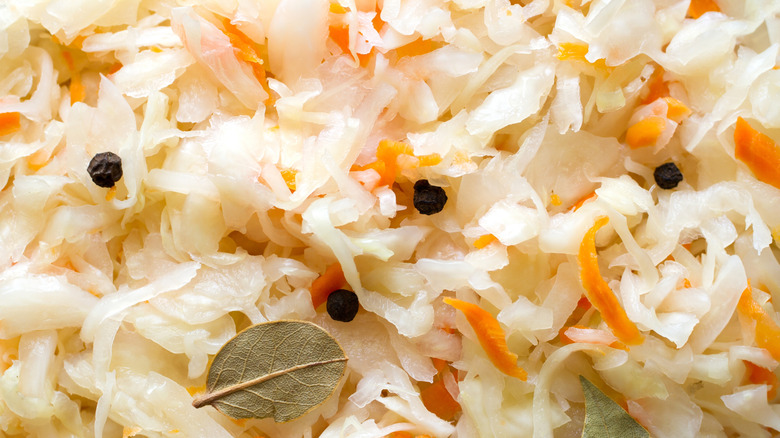What's The Actual Difference Between Raw And Canned Sauerkraut?
If you've purchased sauerkraut in the grocery store before, it may have been found in the refrigerated section next to the pickles, or possibly in an aisle next to the canned vegetables. Whether sold cold or room temperature, in a glass jar or can, it's still sauerkraut. At its core, this product is simply chopped and fermented cabbage. However, the packaging process creates some key differences between the two that affect the taste, texture, price, and even the health benefits — you may want to read on before you make your next purchase.
Both raw and shelf-stable sauerkraut are made the same way — similar to kimchi, it starts with a base of cabbage. Thinly sliced cabbage — red or green cabbage are both used – is mixed with salt and sometimes other spices, weighed down and then fermented at room temperature.
Here's where the main difference occurs: Raw sauerkraut goes straight from fermentation to being packaged. This product is not heated, hence the label "raw." Although it has been fermenting at room temperature, once in the package, it is refrigerated. From the time it is packaged until you buy it from the store and bring it home, it should remain refrigerated. For sauerkraut that will become a shelf-stable product, it is packaged in a jar or can, and then heated. The heating process stops the fermentation process and kills off any bacteria that could grow and ruin the product, giving this product a shelf life of a few years.
Difference in price, texture, and taste
Shelf-stable sauerkraut is appealing because it tends to have a lower price tag — it can often be found for $2-$4. It's more expensive to transport and store refrigerated products, so an item like this that can be stocked in the aisle tends to be more affordable. Raw sauerkraut typically lists a higher price tag because it takes more energy and effort to transport it and consistently keep it at the correct temperature. Often, raw sauerkraut is made by a local producer — or at least a domestic one — due to the logistics of keeping a fresh, raw product intact.
Now the important part: Taste and texture. These are two of the most important factors to consider when purchasing a food product. In general, both shelf-stable and raw sauerkraut will have a similar taste, briny and somewhat salty. Raw sauerkraut will have more of a fresh, vibrant flavor, and maintain a lot of the crunchiness that is found in unfermented, raw cabbage. The canned variety will have lost some of the freshness and crunchy snap due to the heating process.
Health benefits of raw and canned sauerkraut
Sauerkraut and other fermented vegetables are touted for their health benefits — specifically for being a natural source of probiotics. One major benefit of refrigerated sauerkraut brands is that they typically contain probiotics, while shelf-stable versions do not, as the heating process kills these off. The benefits of probiotics are vast, and still being researched; overall they help support a healthy gut microbiome. With a healthy gut, you're able to more easily fight off the things you don't want with a stronger immune system.
While eating a serving of sauerkraut won't immediately give you a healthy gut biome, eating fermented foods like this will help support it over time. Be aware that just because sauerkraut is refrigerated, this doesn't mean it's guaranteed to contain probiotics. A little more investigating is required — the packaging should indicate that it contains probiotics, or what is sometimes referred to as "live active cultures."
Aside from probiotics, raw sauerkraut is higher in vitamin C, some enzymes, and other vitamins and minerals when compared to its shelf-stable counterpart. The heating process also kills off these beneficial nutrients that the body needs to survive and thrive. So if you're eating sauerkraut just for the purpose of a garnish on a sandwich or alongside a German bratwurst, the shelf-stable type is fine. If you're eating it for the health benefits, invest a few extra dollars for the raw, unpasteurized version.


